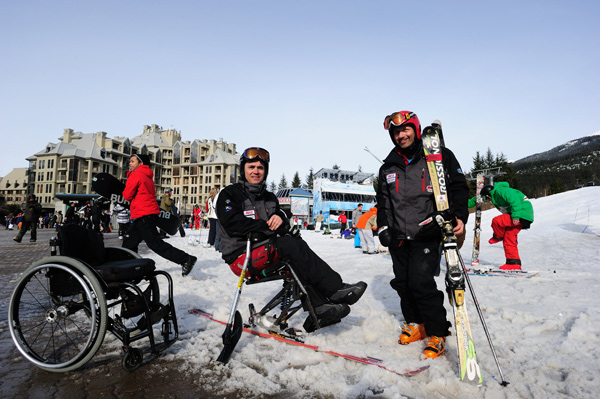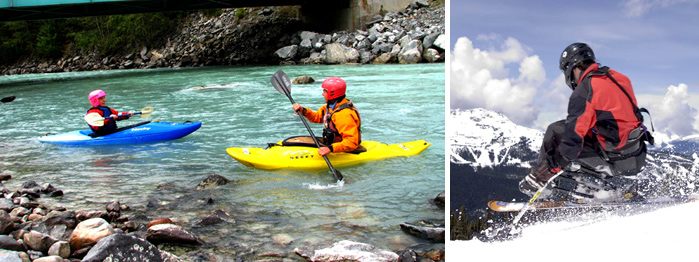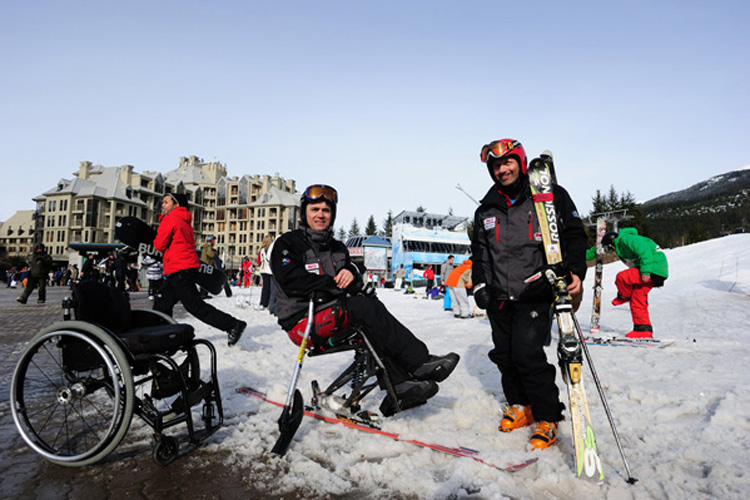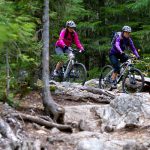Accessibility in Whistler blog written by Special Guest Author Norm DePlume
I broke my neck while skiing on Whistler several years ago. I won’t go so far as to say, “No big deal,” but life rolls on, and so do I. I’m still skiing in Whistler, laughing at jokes, calling my mother on Sundays and generally being a happy, healthy, and productive member of the community. Life rolls on.
Whistler and Disabilities
Admittedly, not many people think of Whistler as a place to find a lot of people with disabilities. It’s known for a rather active lifestyle and, thanks to the many after-school TV specials focusing on “the struggle,” people with disabilities aren’t generally stereotyped as being all that active.
The truth is, however, that while some people are born with disabilities, a large number acquire a spinal cord injury later in life. They were active before their accident and have no desire to give up on that lifestyle just because they now use a wheelchair to help them get around.

Two members of the BC Para Alpine Ski team at the base of Whistler Mountain
As someone who uses a wheelchair and also skis, kayaks, bikes, and jumps off bridges and out of planes, I can honestly say it always make me chuckle derisively when I hear newscasters describe someone as now being “confined to a wheelchair”. I can easily hop into my kayak, or my sit ski, and escape the “confinement” of my wheelchair by blowing past people on the slopes, or gliding along with the ducks and otters on the lake or rivers.
And so can Whistler’s visitors, thanks to organizations like the Whistler Adaptive Sports Program (W.A.S.P) and the Rick Hansen Foundation. These organizations allow people with disabilities who come to Whistler to disprove the old stereotypes by getting back to what they love to do. Or trying something new.
The Whistler Adaptive Sports Program
In 1999, with just a handful of equipment stored in a closet, the homegrown Whistler Adaptive Sports Program began taking people up the mountain to experience sit skiing. These days the program has grown to the point where they’re able to provide over 1400 lessons each ski season, and have expanded into summer programs that include hiking, biking, canoeing, and kayaking.

Aside from illuminating how many abilities people with disabilities actually have, the 2010 Paralympic Games were the best thing to happen to Whistler Village in terms of accessibility. Before the Paralympics occurred Whistler was still pretty good, you could usually get to most places, just not always in the most direct route (underground nightclubs were always a challenge) but since the Games things have been incredible. We now have maps explaining the best routes around the village and outlining which areas of the stroll have stairs, phones and bank machines equipped for the visually and/or hearing impaired. As far as ski towns go, Whistler is easily one of the most accessible.
I’m biased, of course, because I love it here, but that’s just how I roll.

Don’t worry, the bungee cord was Photoshopped out of this picture to make it funnier. Pete is alive and well.


